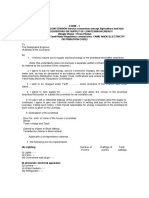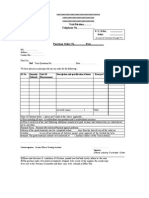Selection of Generator
Uploaded by
sbpathiSelection of Generator
Uploaded by
sbpathiGENERATOR SELECTION
Generators must be sized to handle their load based on the continuous KW, kilowatt load, and KVA, kilovoltamp load, and the worst case starting load KW + KVA. They must be derated for temperature and elevation. They are sized also on whether they are continuous or standby use. The following steps are used to obtain information:
1. Select System Voltage and Phase
a. Three phase - 120/208V, 3 phase, 4W wye; 277/408, 3 phase, 4W wye; * 120/240V 3 phase, 4W Delta
* Should not use on generator as it overloads 1 phase if there are large 120 volt loads.
b. 120/208V, 3 phase, 4W- This is a good choice for a three phase system because you can balance 120 volt loads around the wye to equally load the generator. 208V single phase and 208V three phase loads can be used as well as 120V single phase loads. Motors must be rated 200 volt operation; 240 volt resistance heating equipment used on a 208V generator will only produce 75% of its rated KW output.
c. 277/480, 3 phase, 4W- This voltage is usually used on large systems to reduce incoming service size, wire size and distribution equipment size. Fluorescent and other discharge lighting can be used at 277 volts. 480 volt single phase, 480V three phase, and 277 volt single phase loads can be used on this system. Also good for minimizing voltage drops on long runs. Disadvantages are that a step down transformer is required to get 120/208 or 120/240 volt power for lights and outlets. Motors should be started directly from the generator buss, not from a step down transformer to minimize voltage drop.
d. 120/240V, 3 phase, 4 W Delta- This is the least desirable voltage to use if there is a large amount of 120 volt load. The generator can not be balanced and may overheat the windings. Advantages are 240 volt motors and equipment are more common than 200 volts.
e. 120/240V, 1 phase, 3W This is the standard voltage for single phase systems. Motors are limited to 10HP maximum. Either 120 volts or 240 volts can be used to supply loads. 120 volt loads must be balanced across the generator L1 to N and L2 to N.
Disadvantages are that single phase motors are more unreliable than three phase motors, especially capacitor start motors. The voltage drop is higher in single phase systems for a given load for the same wire size used in 3 phase systems.
2. List Loads (for each load, list the following) a. Voltage b. Phase c. Horsepower if motor, STARTING CODE LETTER d. Running KW, Running KW= starting KW if PF = 1 e. Starting KW f. Running KVA, Running Power Factor g. Starting KVA, Starting Power Starting h. Motor full load amps from nameplate
See Table 2 Onan book for motor data
3. Resistive Loads
Resistive loads consist of incandescent lights, water heaters, electric heaters, stoves, and electric furnaces. Power factor = 1, KW = KVA. Running and starting KW are the same.
4. Motors and Inductive Loads
Motors are inductive loads with KVA always larger than KW. The power factor running usually is between 0.6 and 0.85.
P.F. = KW KVA
KW = (KVA) (PF)
KVA = KW PF
Determine locked rotor code letter from Table 2, A-R, for a given horsepower motor. If the motor is existing, use nameplate data. If this is a new installation, use shaded blocks in Table 2. Find starting KVA from Table 3. Find starting power factor from Table 2. Calculate KW starting = (KVA start) (PF start).
To find starting KVA if only locked rotor amps are known;
1 phase KVA start (locked rotor amps) (voltage)
3 phase KVA start 3 ( locked rotor amps) ( voltage)
For submersible water pumps only, use page 24-17,18 for motor data. To find running KW and KVA if only full load current is known;
1 phase KVA ( I full load current) ( voltage) (KVArun ) ( power factor running )
Kwrun
See Table 2 for given HP, PF = KW KVA
5. Voltage Dip
Determine maximum percentage voltage dip. This is basically what sizes the generator. If voltage dip is too large, the motor will over heat or not start because there is not enough torque to accelerate the motor. Motor torque falls off approximately as the product of reduced squared. For example, with a 30% voltage dip resultant torque, it will be:
T= (.70 volts) 2 = .49 or 49% available torque.
Voltage dip is usually expressed as a percent dip of nominal voltage as measured by light beam oscillograph or pen recorder on the first cycle. This is the voltage dip due to the generator winding resistance before the regulator tries to make the voltage recover. This will last anywhere from 1 cycle to 30 cycles depending on the response of the generator. This voltage dip is usually called the initial or transient voltage dip. After the regulator makes the generator recover, there is a recovery voltage dip from 5 cycles until the motor reaches 70%-90% of synchronous speed.
The sustained voltage dip must be kept low enough to insure that relays and motor starter do not drop out.
6. Voltage Dropout Problems on Motor Control Systems
Recovery dip should be limited to 5% if there are control relays and motor starters unless special precautions are taken in the control system power supply. If the voltage dips low enough to drop out the starters, the motor starters will chatter, burning out the motor. There are three ways to prevent system oscillation.
a. Size generator for 5% initial voltage dip ( RMS). This will result in a larger generator size. b. On small systems where the generator is the only power source, utilize D.C. voltage from the generator battery as the control power. c. If the generator is a standby unit, utilize a constant voltage transformer in the control system power supply, such as a Sola CVS. This will keep the voltage to the control relays to within 95% of nominal voltage with up to 30% dip on the primary.
7. Recovery Voltage Dip
This voltage dip occurs from 5-30 cycles after load is applied. This dip should be no more than 5%. This dip is not given in the manufacturers standard literature. Each application must be checked with the generator manufacturer.
8. Total Voltage Dip
The total voltage dip is the sum of the generator voltage dip and the voltage drop to the load on the conductors. This total should not exceed 10% on starting.
9. Resistive Voltage Dip
For resistive loads, the starting and running voltage dip in the conductors is the same. The formula for voltage drop is:
1 phase Voltage Drop Vd= 2(I) (Z) (L)
I = Current Amps
Z = Total impedance ohms per 1,000 feet of conductor
L = One way length of conductors kilo feet
P.F. = Power Factor = 1.0 (use this when looking up Z)
Refer to Electrical Design/Operation Maintenance Manual R6-1980 (pages 8-1, 8-6 for voltage drop tables). Size feeders for resistive loads at 2% voltage drop.
3 phase Voltage Drop Vd = (3 ) ( I) ( Z) ( L) P.F. = 1.0
% Vd = Vd (100) Base volts Example:
2 volts (100) 240 volts
= .8%
Use same tables for 1 phase, or 3 phase voltage drop.
Reactive Dip Example
Loads Voltage: 120/240V, 1 phase Resistive load: 2 KW, 240V; 1 KW, 120V; 1.5 KW, 120 volt. Total resistive load:
I=
2 KW .23KV =
8.7 A on L1, and L2
I=
1 KW .115 KV =
8.7 A on L1
I=
1.5 KW .115 KV =
13.04 on L2
Total Resistance Load:
2 KW 1 KW 1.5 KW
L1 8.7A 8.7A
17.4
L2 8.7A 0 13.04 21.74
Use the 21 amps for sizing the generator. A voltage drop calculation normally does not need to be done if the generator is close to the distribution panel where the loads receive their power, say 25 feet or less. Conductors for loads must be sized for their ampacity, use NEC 31016 first, then check for voltage drop.
For the 2KW load, 2 #12 Cu wire would be used with a 2 pole 15 amp breaker.
For the 1 and 1.5 KW loads 2 #12 Cu with a 1 pole 20 amp breaker would be used.
Refer to O&M Manual, Section 3 for sizing conductors.
These are the wire sizes for ampacity. Now check voltage drop. NEC ampacity tables do not take into account voltage drop.
Conductor Voltage Drop for Resistive Loads and Wire Sizes
I = 8.7A
Length = 250 feet
#12 CU in conduit PF = 1
Vd = 2 I Z L from page 24-14 #12, Z = 1.62 / Kft.
Vd= (2) (8.7A) (1.62 /Kft.) (.25Kft.) = 7.04 volts = 1.92%
%Vd = Vd 100 = (7.04V) (100) Base volts 230V
So #10 is o.k. for voltage drop.
Motor Voltage Drop In Feeder Conductors
Motor 2HP, 230V, 1 Phase, code letter J, capacitor start, conductor length = 300 ft. Full load current from NEC table 430-148, I = 12 amp.
Onan Book, Table 2, 2 HP, Code J
Starting KVA = 16.4 KVA
Run KVA = 2.6 KVA
Start KW = ( KVA start) ( PF start) = (16.4) ( .9) = 14.76 KW
Run KW = 1.8 KW
Istart = 16.4 KVA = 71.30 amp .23KV
Irun= 12 amp
Inrush = 71.30 amp start 12 amp run
= 5.9 times running current
So if we size the wire for 1% voltage drop on running, we will have about a 6% voltage drop on starting. If this 6% voltage drop is added to the generator recovery voltage drop of 5%, the total overall voltage drop will be about 11%. NEMA says motors need 90% of voltage to start.
Size Conductors
Vd = 2 I Z L
Z = Vd 2IL
L = .3Kft.
Vd = 1% = (.01) (230V) = 2.3V
Z=
= .319/ Kft. 2.3 2(12 amp) (.3 Kft.)
@ .8 P.F. running, page 8-4 O&M, CU wire #4, Z = .2365/Kft. Voltage Drop for #4 CU Vd = 2 I Z L = (2) (12) (.2365) (.3 Kft.) = 1.70V
% Vd = (1.70V) (100) = .74% 230V Starting voltage drop (cable only) = ( .74%) (5.9) = 4.14%
Sizing Gnerator
WHEWWere finally at the good stuff. How do you size the generator itself? Well first of all, dont use the tables in the Onan book I just gave you. They do not cover voltage drop. Each case must be referred to the manufacturer to size the generator. If the generators are loaded to their maximum output indicated in the tables, there may be as much as 10% or more voltage dip without considering wire voltage drop which may not work with a system with motors. Anyway, on with the procedure:
1. Given Loads
2HP, 230V, 1 phase, code J Start KVA = 16.4 Run KVA = 2.6 Start KW = 114.76 start P.F. = 0.8 Run KW = 1.8
Resistance Loads 4.5 KW, 230V, 1 phase Assume resistance loads are balanced
2. Go to Onan Load Sheet, page 24-9; write down resistive loads on column 12 and 13, KW = KVA so entries are the same on line 1.
3. List motor loads with the worst case (largest load applied last) in order on the load form, line 2-16.
If a system manual motor start, starting largest motor first may reduce generator size. If other loads are already running and this starting sequence is not followed, the generator may be overloaded or motors may drop out or not start.
List the following items from Table 2, Onan Book, page 7 for each motor load:
HP Starting Code Letter Volts Starting KVA, starting power factor Starting KW Running KVA Running KW
4. Column 10: Add column 6 to previous line column 12. Column 11: Add column 7 to previous line column 13. Column 12: Add column 8 to previous line column 12. Column 13: Add column 9 to previous line column 13. 5. Look at the largest numbers in columns 10, 11, 12 and 13. Generator output must be greater than these numbers.
WARNING THIS DOES NOT TAKE INTO ACCOUNT VOLTAGE DROP ON GENERATOR. CONSULT MANUFACTURER AT THIS POINT.
Look at Example pages 24-9. 11 Max. KW 12 Cont. KVA 13 Cont. KW
10 Max. KVA
Onan generator 20ES
20.9 42
19.2 22
7.1 25
6.3 20
This applies to Onan only, other generators by other manufacturers have different characteristics.
In this case, a 20 KW generator would handle the continuous KVA and KW, and maximum KVA and KW. Refer to pages 3-6, Onan T-009 Generator Selection Guide.
Sizing for Submersible Water Pump Motors
Submersible water pump motors have a higher than normal locked rotor code letter and running current than Onan tables shown for average motors. The running current is higher than NEC 430-148 when run at their service factor amps. Use the following attached tables:
You might also like
- The Subtle Art of Not Giving a F*ck: A Counterintuitive Approach to Living a Good LifeFrom EverandThe Subtle Art of Not Giving a F*ck: A Counterintuitive Approach to Living a Good Life4/5 (6124)
- The Gifts of Imperfection: Let Go of Who You Think You're Supposed to Be and Embrace Who You AreFrom EverandThe Gifts of Imperfection: Let Go of Who You Think You're Supposed to Be and Embrace Who You Are4/5 (1148)
- Never Split the Difference: Negotiating As If Your Life Depended On ItFrom EverandNever Split the Difference: Negotiating As If Your Life Depended On It4.5/5 (933)
- Hidden Figures: The American Dream and the Untold Story of the Black Women Mathematicians Who Helped Win the Space RaceFrom EverandHidden Figures: The American Dream and the Untold Story of the Black Women Mathematicians Who Helped Win the Space Race4/5 (954)
- The Hard Thing About Hard Things: Building a Business When There Are No Easy AnswersFrom EverandThe Hard Thing About Hard Things: Building a Business When There Are No Easy Answers4.5/5 (361)
- The World Is Flat 3.0: A Brief History of the Twenty-first CenturyFrom EverandThe World Is Flat 3.0: A Brief History of the Twenty-first Century3.5/5 (2283)
- Devil in the Grove: Thurgood Marshall, the Groveland Boys, and the Dawn of a New AmericaFrom EverandDevil in the Grove: Thurgood Marshall, the Groveland Boys, and the Dawn of a New America4.5/5 (278)
- A Heartbreaking Work Of Staggering Genius: A Memoir Based on a True StoryFrom EverandA Heartbreaking Work Of Staggering Genius: A Memoir Based on a True Story3.5/5 (692)
- Wire Lengths of AC and DC Discrete Signals On Field Side of IO ModulesNo ratings yetWire Lengths of AC and DC Discrete Signals On Field Side of IO Modules2 pages
- The Subtle Art of Not Giving a F*ck: A Counterintuitive Approach to Living a Good LifeFrom EverandThe Subtle Art of Not Giving a F*ck: A Counterintuitive Approach to Living a Good Life
- The Gifts of Imperfection: Let Go of Who You Think You're Supposed to Be and Embrace Who You AreFrom EverandThe Gifts of Imperfection: Let Go of Who You Think You're Supposed to Be and Embrace Who You Are
- Never Split the Difference: Negotiating As If Your Life Depended On ItFrom EverandNever Split the Difference: Negotiating As If Your Life Depended On It
- Hidden Figures: The American Dream and the Untold Story of the Black Women Mathematicians Who Helped Win the Space RaceFrom EverandHidden Figures: The American Dream and the Untold Story of the Black Women Mathematicians Who Helped Win the Space Race
- The Hard Thing About Hard Things: Building a Business When There Are No Easy AnswersFrom EverandThe Hard Thing About Hard Things: Building a Business When There Are No Easy Answers
- Elon Musk: Tesla, SpaceX, and the Quest for a Fantastic FutureFrom EverandElon Musk: Tesla, SpaceX, and the Quest for a Fantastic Future
- The Emperor of All Maladies: A Biography of CancerFrom EverandThe Emperor of All Maladies: A Biography of Cancer
- The Little Book of Hygge: Danish Secrets to Happy LivingFrom EverandThe Little Book of Hygge: Danish Secrets to Happy Living
- The Yellow House: A Memoir (2019 National Book Award Winner)From EverandThe Yellow House: A Memoir (2019 National Book Award Winner)
- The World Is Flat 3.0: A Brief History of the Twenty-first CenturyFrom EverandThe World Is Flat 3.0: A Brief History of the Twenty-first Century
- Devil in the Grove: Thurgood Marshall, the Groveland Boys, and the Dawn of a New AmericaFrom EverandDevil in the Grove: Thurgood Marshall, the Groveland Boys, and the Dawn of a New America
- The Sympathizer: A Novel (Pulitzer Prize for Fiction)From EverandThe Sympathizer: A Novel (Pulitzer Prize for Fiction)
- Team of Rivals: The Political Genius of Abraham LincolnFrom EverandTeam of Rivals: The Political Genius of Abraham Lincoln
- A Heartbreaking Work Of Staggering Genius: A Memoir Based on a True StoryFrom EverandA Heartbreaking Work Of Staggering Genius: A Memoir Based on a True Story
- On Fire: The (Burning) Case for a Green New DealFrom EverandOn Fire: The (Burning) Case for a Green New Deal
- Wire Lengths of AC and DC Discrete Signals On Field Side of IO ModulesWire Lengths of AC and DC Discrete Signals On Field Side of IO Modules
- The Unwinding: An Inner History of the New AmericaFrom EverandThe Unwinding: An Inner History of the New America






















































